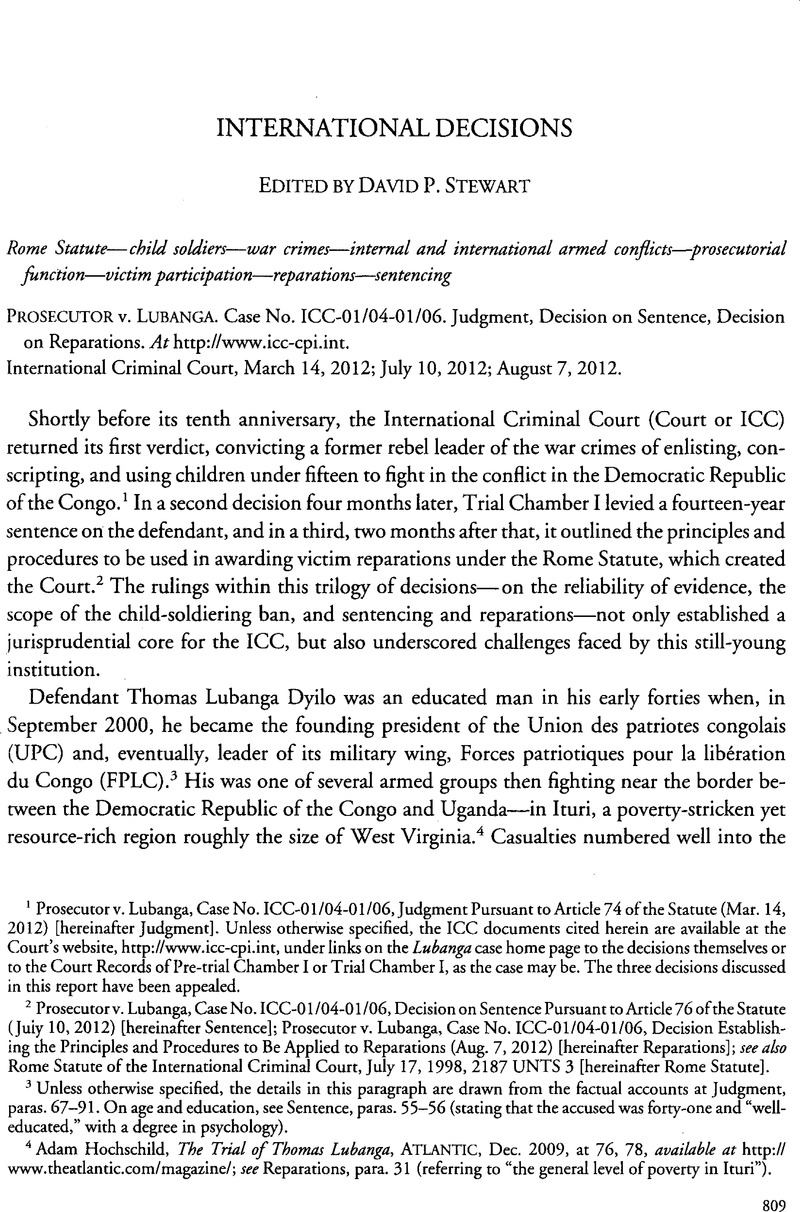Published online by Cambridge University Press: 20 January 2017

1 Prosecutor v. Lubanga, Case No. ICC-01/04-01/06, Judgment Pursuant to Article 74 of the Statute (Mar. 14, 2012) [hereinafter Judgment]. Unless otherwise specified, the ICC documents cited herein are available at the Court’s website, http://www.icc-cpi.int, under links on the Lubanga case home page to the decisions themselves or to the Court Records of Pre-trial Chamber I or Trial Chamber I, as the case may be. The three decisions discussed in this report have been appealed.
2 Prosecutor v. Lubanga, Case No. ICC-01/04-01/06, Decision on Sentence Pursuant to Article 76 of the Statute (July 10, 2012) [hereinafter Sentence]; Prosecutor v. Lubanga, Case No. Icc-01/04-01/06, Decision Establishing the Principles and Procedures to Be Applied to Reparations (Aug. 7, 2012) [hereinafter Reparations]; see also Rome Statute of the International Criminal Court, July 17, 1998, 2187 UNTS 3 [hereinafter Rome Statute].
3 Unless otherwise specified, the details in this paragraph are drawn from the factual accounts at Judgment, paras. 67-91. On age and education, see Sentence, paras. 55-56 (stating that the accused was forty-one and “well-educated,” with a degree in psychology).
4 Hochschild, Adam, The Trial of Thomas Lubanga, Atlantic, Dec. 2009, at 76, 78Google Scholar, available at http://www.theatlantic.com/magazine/; see Reparations, para. 31 (referring to “the general level of poverty in Ituri”).
5 See ICC Press Release, Statement by Luis Moreno-Ocampo, Press Conference in Relation with the Surrender to the Court of Mr Thomas Lubanga Djilo (Mar. 18, 2006), at http://www.icc-cpi.int/Nr/rdonlyres/699D1671-4841-4Aac-Bff4-1F1Bf3F9Dfec/143842/Lmo_20060318_Enl.pdf (noting that since “July 2002, 8, 000 people were killed” in Ituri, and “600,000 people displaced”), quotedin James Benoit, Paul, The Evolution of Universal Jurisdiction over War Crimes, 53 Naval L. Rev. 259, 305 n.333 (2006)Google Scholar; see also Reparations, para. 44 (stating that the Trust Fund for Victims estimated victims in the “thousands,” without specifying whether “victims” referred only to child soldiers, or also to other persons harmed in the conflict).
6 See Judgment, para. 9; Rome Statute, supra note 2, Art. 14 (authorizing referral of situation by state party).
7 Prosecutor v. Lubanga, Case No. ICC-01/04-01/06, Decision on the Confirmation of Charges 156-57 (Jan. 29, 2007) (reported by Drumbl, Mark A. at 101 AJIL 841 (2007 Google Scholar)).
8 The three teams were the ICC Office of Public Counsel for Victims and two groups designated, respectively, as “Voi” and “V02.” See, e.g., Judgment, paras. 52, 61, 64; Reparations, para. 13.
9 Here the chamber adapted the “overall control” test set forth in Prosecutor v. Tadić, Case No. IT-94-1-A, paras. 120-40 (July 15, 1999), at http://www.icty.org.
10 As detailed in the Judgment, para. 541 & n. 1646, the internally quoted phrase adapts commentary on Article 2 common to the four Geneva Conventions on the Protection of Victims of War of 1949.
11 Quoting Rome Statute, supra note 2, Art. 30(2)(b), (3) (describing the mental elements of “intent” and “knowledge,” respectively).
12 see also Judgment, Separate Opinion of Judge Adrian Fulford, para. 20.
13 See Sentence, para. 21; Rome Statute, supra note 2, Art. 77(1) (making no allowance for capital punishment, permitting imposition of prison terms “for a specified number of years, which may not exceed a maximum of 30 years,” and authorizing life sentences only “when justified by the extreme gravity of the crime and the individual circumstances of the convicted person”).
14 The chamber distinguished, inter alia, Prosecutor v. Sesay, Case No. SCSL-04-15-T, Sentencing Judgment, para. 187 (Apr. 8, 2009), at http://www.sc-sl.org, and Prosecutor v. Fofana, Case No. Scsl-04-14-A, Sentencing Judgment, para. 94 (Oct. 9, 2007), at id.
15 See Sentence, Dissenting Opinion of Judge Odio Benito, paras. 19-25 (supporting her preferred sentence by contending that more consideration should have been given harm from punishments and sexual violence).
16 Trust Fund for Victims, Financial Info, at http://www.trustrundforvictims.org/financial-info (stating that 1 million euros had been put in reserve for this purpose, and that in addition, “approximately €2.2 million were obligated for grants in the Democratic Republic of the Congo and Uganda”).
17 See Prosecutor v. Ntaganda, Case No. ICC-01/04-02/06, Decision on the Prosecutor’s Application Under Article 58, paras. 5, 66, 83 (redacted version, July 13, 2012) (granting the request); see also Marlise Simons, The Hague: New Prosecutor Sworn In, N.Y. Times, June 16,2012, at A9, available in Lexis, News Library, Individual Pubs. File.
18 See Yet Again, Congo Faces the Specter of Civil War (Nat’l Pub. Radio broadcast Sept. 9, 2012), available in lexis, News Library, Most Recent 90 Days File.
19 By way of example, as Lubanga neared judgment, ICC Pretrial Chamber III granted the request of the expresident of Cote “l’lvoire for Taide judiciaire totale.” Prosecutor v. Gbagbo, Case No. ICC-02/11-01/11, Decision relative a la «Requete de la Defense sur le champ de Taide judiciaire», para. 4 (Jan. 27, 2012).
20 To the extent that such details are provided supra in text at notes 3-5, 7, they turn on sources other than the Judgment.
21 Cassese, Antonio, Reflections on International Criminal Justice, 61 Mod. L. Rev. 1, 6 (1998)Google Scholar (emphasis omitted).